

| Circe
| Wednesday, October 14, 2009 Other business kept me out of the shop all morning, but in the afternoon I began by washing and sanding yesterday's new tabbing in the galley and head, and vacuuming up the dust. I also cut off the excess of the old aft bulkheads that protruded past the inboard ends of the new bulkheads that I'd installed earlier. |
|
In preparation for additional construction work in the head compartment, we decided upon the MSD to use (Lavac Popular), and I ordered one so that I could have it on hand to ensure practicable and safe placement of the head--which would drive the height, size, and placement of the support platform and other joinerwork in the head. I wanted to be sure that the head would be comfortable to use, and also hoped to install it so that the rim of the bowl was above the static waterline--even though Lavac heads, with their different design, don't tend to backflood like some heads do if the intake valves are left open. To that end, I made some measurements and transferred a mark corresponding to the (rough/conservative) waterline location inside the boat for reference. Later, I'd use this mark as a guideline for the ultimate MSD placement, but for now, further construction in the head would wait till the toilet actually arrived. |
 |
|
Meanwhile, I continued work in the galley. During the remainder of the afternoon, I laid out, cut, and fit the longitudinal bulkhead running from the after stove bulkhead to the aftermost bulkhead beneath the cockpit. I first made reference marks on the aft face of the stove bulkhead to register the position of the new bulkhead's finished face--1" back from the edge of the stove enclosure, as on the forward side. I cut and installed the vertical support cleat, as well as a horizontal cleat to support the eventual countertop, and then measured for the length of the new longitudinal bulkhead and cut a blank of 1/2" cherry plywood to rough size. Holding the forward edge tight to the cleats and to the stove bulkhead, I temporarily secured it there with a couple screws, which I inserted through pre-measured and counterbored holes that would end up in the proper position once the bulkhead was at its finished height (and which holes would eventually be bunged, since this was the finished face of the material). Using a square, I set up the blank perpendicular to the transverse bulkhead and made reference marks on the aft bulkhead. |
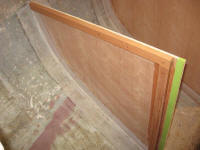
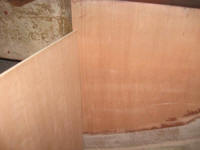 |
|
Drawing a plumb line from the reference mark, I next cut and installed support cleats on the aft bulkhead, for both the vertical bulkhead support and for the eventual countertop support. With these supports in place, I could again temporarily secure the bulkhead blank and scribe the lower edge to fit the contours of the hull, and then cut the bulkhead to the marks. |
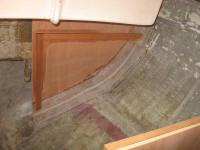
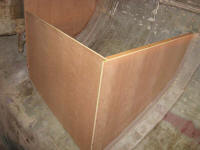
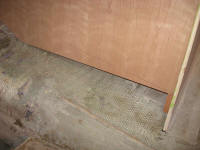 |
|
The point of this rather protracted exercise at this stage--other than to cut and fit a necessary bulkhead--was mainly to determine the possible size and feasibility of an access hatchway through the aft bulkhead into the port cockpit locker behind; at this juncture, I was as yet undecided whether I'd want or need access through the bulkhead for any reason before completing the galley construction, which would then close off access. In any event, the potential access size was rather small, as seen in the photo showing the cleats above, so for the moment I left things alone to mull over before continuing, and to determine whether I'd need this access at all. I wasn't sure I did. The 36" (from the sole) countertop height left approximately 6" between the countertop and the underside of the bridgedeck, a usable-enough distance. The space enclosed in this area would eventually accommodate a standard icebox and galley sink, the configuration and positioning of which would be further determined as construction continued. In these photos, the new longitudinal bulkhead blank is standing in for the eventual countertop. |
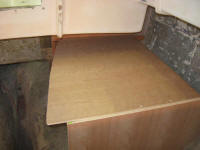
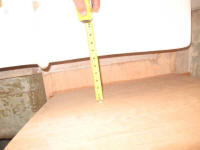 |
|
We'd discussed the possibility of extending the starboard settee aft, through the bulkhead and into the forward part of the starboard cockpit locker. I spent some time determining roughly how much space this might allow, and whether it made sense to contemplate or not. With the natural constraints of the space, permanently bound by the fixed curvature of the hull, the height of the settee, and the protrusions of the cockpit scupper assembly and the deck drain hoses that would eventually be running through the space, I didn't see sufficient advantage to attempting the extension, as at most it would provide a sort of cubbyhole into which one's feet could be inserted for perhaps a foot of length and a foot of width. Instead, I thought it'd be better to construct a good-sized access hatch, which would allow useful access to the space from the cabin (since the fuel tank would otherwise constrict access to this space from the cockpit locker), and to use the space for battery storage, perhaps, or some other bulk storage. |
 |
|